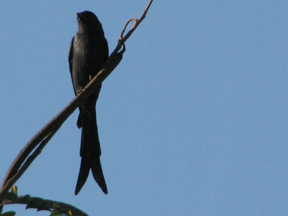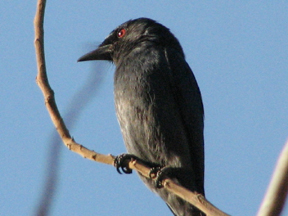Drongo. Dicrurus adsimilis.
-Ragoo Rao
 This month I have the Drongo for the Common Birds column. The Drongos being most active during this part of the
year, they attract a lot of attention even in the urban areas. This season they come out of their strictly wooded areas into the avenue trees also. One can see them early in the mornings and at twilight perching on medium sized tree- tops, looking around
for air-borne insects to catch them mid-air.
This month I have the Drongo for the Common Birds column. The Drongos being most active during this part of the
year, they attract a lot of attention even in the urban areas. This season they come out of their strictly wooded areas into the avenue trees also. One can see them early in the mornings and at twilight perching on medium sized tree- tops, looking around
for air-borne insects to catch them mid-air.
A black bird slightly larger than a bulbul with jet black shining feathers and a long forked tail, sitting on tree
tops and scanning the surrounding for airborne insects is the Drongo or King crow as it is fondly called.
Drongos are mostly found in pairs or sometimes in a flock of upto five birds. Early mornings and late evenings are
their favorite time for foraging and it is really a sight to see their acrobatics in their effort to catch the air-borne insects.
In the cultivated fields, whenever trash is burnt you find the drongos waiting on tree tops to catch the insects flushed
out by the fire. Even shrub fires and grassland fires are sure to bring in a lot of drongos for the opportune feast of insects. 
Distribution is throughout the country. Their almost shikra like calls are a sure sign of a drongo's presence. All
one has to do is look for tree tops where they perch in a position to scan the surroundings. The drongo has also been noticed to like some flower nectar, but they have their favorite blooms.
The nesting season of the drongo is April to August that is in the prime cultivation period of rural areas when the
insect population is also good. The nest is a cup shaped one made of twigs and cobwebs, very similar to that of a bulbul' s nest. For nesting, drongos prefer medium sized trees about 15 to 20 feet from the ground. Four to five whitish brown eggs with red
spots are laid and both parents share all domestic chores. When incubation is going on it is common to find one mate sitting close by acting as a sentry. They are very bold birds and dive bomb any intruders on the ground. Even cats are scared off in this
manner.
A beautiful bird which is a marvel to watch foraging is abundant now, but the fear of dwindling is always there
with the way deforestation is being done. Drongos prefer lone trees standing in the midst of cultivated fields and we have to see that their nesting sites are not decimated or we will lose a marvelous inhabitant of our planet.